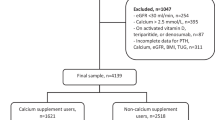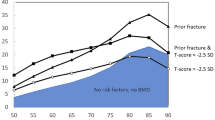Abstract
Summary
Urinary calculi were associated with higher risk of vertebral and upper limb fracture. Therefore, patients with urinary calculi should be evaluated carefully because they may have a higher risk of subsequent fracture later in life.
Introduction
The contribution of urinary calculi to reduced bone mineral density has been recognized. However, the association of urinary calculi with the risk of fracture remains inconclusive. The aim of the study was to determine the risk of overall fracture and fractures at different anatomic sites in patients with urinary calculi.
Methods
The records of inpatients and outpatients with urinary calculi were retrieved from the Taiwan National Health Insurance Database from 2000 to 2010. Among patients with urinary calculi at the cohort entry, controls were matched using propensity scores on a 1:1 ratio. All subjects were followed up from the date of enrollment until fracture occurrence, death, or December 31, 2010. There were 46,243 Medicare beneficiaries with a diagnosis of urinary calculi and 46,243 controls without calculi enrolled.
Results
Among these patients, 6005 patients with a diagnosis of urinary calculi and 5339 controls developed fractures during a median follow-up period of 5.3 years. Patients with urinary calculi had a higher incidence of fracture compared with controls (23.9 versus 22.1 per 1000 person-years) and a greater risk of overall fractures (adjusted hazard ratio [aHR] 1.08, 95 % confidence interval [CI], 1.04–1.12), mainly located at the vertebrae (aHR 1.15, 95 % CI, 1.06–1.25) and upper limb (aHR 1.07, 95 % CI, 1.01–1.14), but the risk for hip fracture was not increased (aHR 1.09, 95 % CI, 0.96–1.22).
Conclusions
Urinary calculus is independently associated with higher risk of subsequent fracture. Patients with urinary calculi should pay attention to the future vertebral and upper limb fractures.


Similar content being viewed by others
References
Cooper C (1997) The crippling consequences of fractures and their impact on quality of life. Am J Med 103:12S–17S, discussion 17S-19S
Bliuc D, Nguyen ND, Milch VE, Nguyen TV, Eisman JA, Center JR (2009) Mortality risk associated with low-trauma osteoporotic fracture and subsequent fracture in men and women. JAMA J Am Med Assoc 301:513–521
Liu Y, Peng M, Lin L, Liu X, Qin Y, Hou X (2014) Relationship between American Society of Anesthesiologists (ASA) grade and 1-year mortality in nonagenarians undergoing hip fracture surgery. Osteoporos Int J Established Result Cooperation Between Eur Found Osteoporos Natl Osteoporos Found USA
Autier P, Haentjens P, Bentin J, Baillon JM, Grivegnee AR, Closon MC, Boonen S (2000) Costs induced by hip fractures: a prospective controlled study in Belgium. Belgian Hip Fracture Study Group. Osteoporos Int J Established Result Cooperation Between Eur Found Osteoporos Natl Osteoporos Found USA 11:373–380
Lambrelli D, Burge R, Raluy-Callado M, Chen SY, Wu N, Schoenfeld MJ (2014) Retrospective database study to assess the economic impact of hip fracture in the United Kingdom. J Med Econ 17:817–825
Qu B, Ma Y, Yan M, Wu HH, Fan L, Liao DF, Pan XM, Hong Z (2014) The economic burden of fracture patients with osteoporosis in western China. Osteoporos Int J Established Result Cooperation Between Eur Found Osteoporos Natl Osteoporos Found USA 25:1853–1860
Coe FL, Evan A, Worcester E (2005) Kidney stone disease. J Clin Invest 115:2598–2608
Loh NY, Bentley L, Dimke H et al (2013) Autosomal dominant hypercalciuria in a mouse model due to a mutation of the epithelial calcium channel, TRPV5. PLoS One 8:e55412
Lingeman JE, Saywell RM Jr, Woods JR, Newman DM (1986) Cost analysis of extracorporeal shock wave lithotripsy relative to other surgical and nonsurgical treatment alternatives for urolithiasis. Med Care 24:1151–1160
Matlaga BR, Jansen JP, Meckley LM, Byrne TW, Lingeman JE (2012) Economic outcomes of treatment for ureteral and renal stones: a systematic literature review. J Urol 188:449–454
Wu W, Yang D, Tiselius HG, Ou L, Liang Y, Zhu H, Li S, Zeng G (2014) The characteristics of the stone and urine composition in Chinese stone formers: primary report of a single-center results. Urology 83:732–737
Frick KK, Bushinsky DA (2003) Molecular mechanisms of primary hypercalciuria. J Am Soc Nephrol JASN 14:1082–1095
Coe FL, Bushinsky DA (1984) Pathophysiology of hypercalciuria. Am J Physiol 247:F1–F13
Krieger NS, Bushinsky DA (2013) The relation between bone and stone formation. Calcif Tissue Int 93:374–381
Li H, Xie H, Liu W et al (2009) A novel microRNA targeting HDAC5 regulates osteoblast differentiation in mice and contributes to primary osteoporosis in humans. J Clin Invest 119:3666–3677
Xie H, Cui Z, Wang L et al (2014) PDGF-BB secreted by preosteoclasts induces angiogenesis during coupling with osteogenesis. Nat Med 20:1270–1278
Lawoyin S, Sismilich S, Browne R, Pak CY (1979) Bone mineral content in patients with calcium urolithiasis. Metab Clin Exp 28:1250–1254
Pak CY, Oata M, Lawrence EC, Snyder W (1974) The hypercalciurias. Causes, parathyroid functions, and diagnostic criteria. J Clin Invest 54:387–400
Arrabal-Polo MA, Del Carmen C-GM, Canales BK, Arrabal-Martin M (2014) Calcium nephrolithiasis and bone demineralization: pathophysiology, diagnosis, and medical management. Curr Opin Urol 24:633–638
Melton LJ 3rd, Crowson CS, Khosla S, Wilson DM, O'Fallon WM (1998) Fracture risk among patients with urolithiasis: a population-based cohort study. Kidney Int 53:459–464
Lauderdale DS, Thisted RA, Wen M, Favus MJ (2001) Bone mineral density and fracture among prevalent kidney stone cases in the Third National Health and Nutrition Examination Survey. J Bone Min Res Off J Am Soc Bone Min Res 16:1893–1898
Wang KL, Liu CJ, Chao TF, Huang CM, Wu CH, Chen SJ, Chen TJ, Lin SJ, Chiang CE (2012) Statins, risk of diabetes, and implications on outcomes in the general population. J Am Coll Cardiol 60:1231–1238
Wu CY, Chen YJ, Ho HJ, Hsu YC, Kuo KN, Wu MS, Lin JT (2012) Association between nucleoside analogues and risk of hepatitis B virus-related hepatocellular carcinoma recurrence following liver resection. JAMA J Am Med Assoc 308:1906–1914
Charlson ME, Pompei P, Ales KL, MacKenzie CR (1987) A new method of classifying prognostic comorbidity in longitudinal studies: development and validation. J Chron Dis 40:373–383
Chen IJ, Chiang CY, Li YH, et al. (2014) Nationwide cohort study of hip fractures: time trends in the incidence rates and projections up to 2035. Osteoporos Int J Established Result Cooperation Between Eur Found Osteoporos Natl Osteoporos Found USA
Arrabal-Polo MA, Sierra Giron-Prieto M, Orgaz-Molina J, Zuluaga-Gomez A, Arias-Santiago S, Arrabal-Martin M (2013) Calcium renal lithiasis and bone mineral density. Importance Bone Metabol Urinary Lithiasis Actas Urologicas Espanolas 37:362–367
Keller JJ, Lin CC, Kang JH, Lin HC (2013) Association between osteoporosis and urinary calculus: evidence from a population-based study. Osteoporos Int J Established Result Cooperation Between Eur Found Osteoporos Natl Osteoporos Found USA 24:651–657
Caudarella R, Vescini F, Buffa A, La Manna G, Stefoni S (2004) Osteoporosis and urolithiasis. Urol Int 72(Suppl 1):17–19
Keaveny TM, Wachtel EF, Ford CM, Hayes WC (1994) Differences between the tensile and compressive strengths of bovine tibial trabecular bone depend on modulus. J Biomech 27:1137–1146
Melton LJ 3rd, Kan SH, Frye MA, Wahner HW, O'Fallon WM, Riggs BL (1989) Epidemiology of vertebral fractures in women. Am J Epidemiol 129:1000–1011
Homminga J, Weinans H, Gowin W, Felsenberg D, Huiskes R (2001) Osteoporosis changes the amount of vertebral trabecular bone at risk of fracture but not the vertebral load distribution. Spine 26:1555–1561
Melton LJ 3rd, Crowson CS, O'Fallon WM (1999) Fracture incidence in Olmsted County, Minnesota: comparison of urban with rural rates and changes in urban rates over time. Osteoporos Int J Established Result Cooperation Between Eur Found Osteoporos Natl Osteoporos Found USA 9:29–37
Bushinsky DA, Willett T, Asplin JR, Culbertson C, Che SP, Grynpas M (2011) Chlorthalidone improves vertebral bone quality in genetic hypercalciuric stone-forming rats. J Bone Mineral Res Off J Am Soc Bone Min Res 26:1904–1912
Sella S, Cattelan C, Realdi G, Giannini S (2008) Bone disease in primary hypercalciuria. Clin Cases Min Bone Metabol Off J Italian Soc Osteoporos Min Metabol Skelet Dis 5:118–126
Carrasco-Valiente J, Anglada-Curado FJ, Aguilar-Melero P, Gonzalez-Ojeda R, Muntane-Relat J, Padillo-Ruiz FJ, Requena-Tapia MJ (2012) State of acute phase markers and oxidative stress in patients with kidney stones in the urinary tract. Actas Urol Esp 36:296–301
Szlosarek P, Charles KA, Balkwill FR (2006) Tumour necrosis factor-alpha as a tumour promoter. Eur J Cancer 42:745–750
Montalcini T, Romeo S, Ferro Y, Migliaccio V, Gazzaruso C, Pujia A (2013) Osteoporosis in chronic inflammatory disease: the role of malnutrition. Endocrine 43:59–64
Samelson EJ, Hannan MT, Zhang Y, Genant HK, Felson DT, Kiel DP (2006) Incidence and risk factors for vertebral fracture in women and men: 25-year follow-up results from the population-based Framingham study. J Bone Min Res Off J Am Soc Bone Min Res 21:1207–1214
Sacks H, Chalmers TC, Smith H Jr (1982) Randomized versus historical controls for clinical trials. Am J Med 72:233–240
Benson K, Hartz AJ (2000) A comparison of observational studies and randomized, controlled trials. Am J Ophthalmol 130:688
Acknowledgments
This study was supported to Dr. D.C. Tarng by grants from the National Science Council, Taipei Veterans General Hospital, Foundation for Poison Control, and Ministry of Education’s aim for the Top University Plan. This study was based in part on data from the NHIRD provided by the Bureau of NHI, Department of Health and managed by National Health Research Institutes. The interpretation and conclusions contained herein do not represent those of Bureau of NHI, Department of Health, and National Health Research Institutes.
Conflicts of interest
None.
Author information
Authors and Affiliations
Corresponding author
Additional information
Shuo-Ming Ou and Yung-Tai Chen contributed equally to this study.
Rights and permissions
About this article
Cite this article
Ou, SM., Chen, YT., Shih, CJ. et al. Increased risk of bone fracture among patients with urinary calculi: a nationwide longitudinal population-based study. Osteoporos Int 26, 1261–1269 (2015). https://doi.org/10.1007/s00198-014-2998-5
Received:
Accepted:
Published:
Issue Date:
DOI: https://doi.org/10.1007/s00198-014-2998-5




